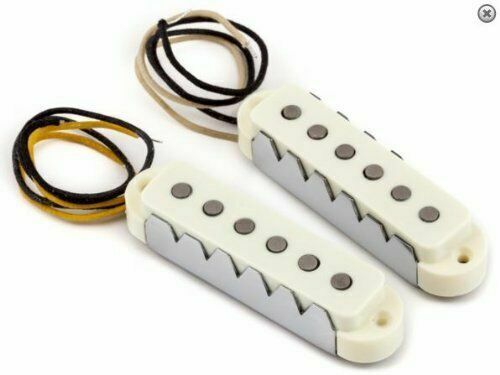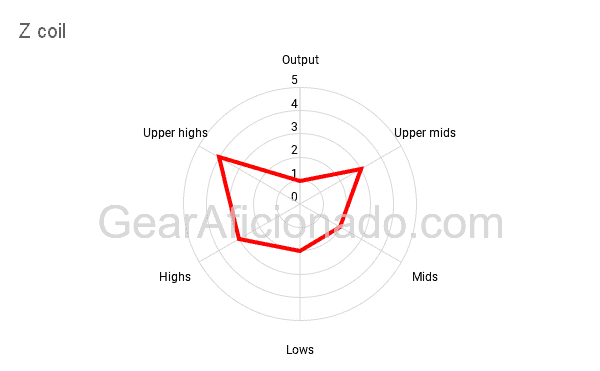For many people, pickups are the most important feature of a guitar.
Some will even go as far as to claim that pickups are the only factor that defines an electric guitar’s tone.
I would not go that far. However, I agree with the idea that they are one of the defining factors of an instrument’s sound.
But how and how much do different types of pickups affect a guitar’s tone? Here is a short answer:
Different types of pickups have a radical effect on an electric guitar’s tone. It is like using different EQ filters over the natural sound of the instrument. Each style of pickup will cut different frequencies from the spectrum with dissimilar intensity imprinting their own personality to the guitar.
For those who want to dive deeper into this topic, in this article, I will talk about how pickup type is important, and how much does it affect the final tone.
After that, I will describe the most common types of pickups briefly and give you some insights into their sound profiles.
Finally, I will give you my conclusions and recommendations in regard to this topic.
Are you ready to get started?
Let’s go!
How do different types of pickups affect tone?
Pickups are not all built the same.
In fact, in the early days of electric guitars, there was noticeable variability between the same model pickups made just days apart.
Factors like the quality of components, or even slight changes in their construction made for great differences in tone.
Going a step further, when you consider pickups constructed in a different manner and shape, it’s absolutely obvious that there will be tonal differences.
It’s important, however, to have a general idea of how electric guitar pickups work to keep diving into this rabbit hole.
Guitar pickups are comprised of magnets that generate a magnetic field around them. This magnetic field is sensitive to the vibration the strings produce when plucked. Those perceived vibrations are, in turn, transformed into a signal that is transmitted to the amplifier.
With this in mind, you could imagine that different components and configurations will easily result in different magnetic fields and different sensitivities to their fluctuations.
That is, essentially, what makes different kinds of pickups sound different.
How much does pickup type affect tone?
Quantifying how much a component of a guitar affects its tone is a very hard task that would require extensive scientific research.
In this article, I will limit myself to give my opinion based on my experience and research. This, of course, is completely empirical and should be taken with a grain of salt.
As I mentioned earlier, many people claim that pickups are the defining factor of an electric guitar’s tone and that nothing else matters.
I disagree.
There are many features that determine how a guitar sounds, from its shape, its construction, materials to electronics. Hey, even the amp will determine a really big portion of the final tone.
Pickups account for a significant portion of what the guitar offers into the tone equation. Some will say that they dictate up to 25% of a guitar’s tone, and that could be true.
We won’t arrive at any significant conclusion, however.
The important thing is that you try out and experiment with what it feels to you. If you have the chance to play similar guitars with different types of pickups, pay special attention and try to isolate the sound of the guitar from the EQ filter each pickup puts it through.
And yes, I like to think about pickups as filters that alter the original “true” sound of the instrument.
Most common pickup types and their effect on tone
Let’s get down to business now.
Every kind of pickup has its own story and sound. I will try to give you a brief idea about what you can expect from the most common ones in no particular order.
Here they are:
Single-coil

What can I say about the single-coil? This is where the iconic Fender sound lies. The oldest concept of them all, and a sound that survived through the ages.
One of its main characteristics is the “60 cycle” hum they produce due to their susceptibility to interference.
In terms of tone, single-coil pickups are balanced and versatile, they have a very clear top end and a slightly scooped midrange that gives them their unique warmth.

Humbucker

Humbuckers started as an idea to eliminate the “60 cycle” hum that haunts single coils until this day. The funny thing is that, in this process, a new paradigm of tone was born.
These pickups sound and look completely different than their older brother and what was sought after as an upgrade in design, really resulted in a forking path that led to many modern sounds.
In terms of tone, humbuckers have a higher output, are more responsive in the low end, and sound darker.

P90

P90s are pretty much Gibson’s version of a single-coil pickup. They actually have just one bobbin and, as expected, they are susceptible to the “60 cycles” hum. These ones predate the humbuckers which replaced them in the standard version of most modern Gibson guitars.
In terms of tone, P90s are not as responsive in the low end but have very present mids. The top end is not a strong point, and some players might define them as muddy. That claimed muddiness should not be considered as a downside but as a feature.

Mini humbucker

Mini humbuckers are just humbuckers in a smaller format. This, however, essentially changes their interaction with the strings and results in a particularly different sound than the one their normal-sized siblings offer.
In terms of tone, and contrary to what many imagine, mini-humbuckers are closer to a single-coil pickup than even a P90 is. They sound slightly mid-scooped and have a really clear and bright high end.

Active pickups

Active pickups are a modern version of the guitar pickup. They were popularized mostly by metal players that look for an extra boost in their tone.
The active part of the system includes a preamp which in many cases will allow the player to EQ the signal before it hits the amp. These amenities, however, require a 9-volt battery inserted in the body of the instrument to function.
In terms of tone, Active pickups are output monsters and are very comparable with a high output humbucker pickup. Their sound is very polarizing across the player base, and I personally think they might lack a bit in their dynamic response (variability in volume from playing with contrasting intensities).

Piezo pickups

Piezo pickups are not quite what you think of when talking about electric guitar pickups, but as many guitars incorporate them I decided to add them to this list.
This kind of pickup work with crystals instead of magnets to generate an amplifiable signal. I won’t go into specifics here, but you just have to know that they are used mostly in acoustic instruments.
In terms of tone, Piezo pickups capture the acoustic sound of the guitar. They are great for faking an acoustic guitar sound. However, they are known from a lack in low end that tends to make them sound a little on the harsher bright side.

Gold foil

Gold foil pickups are not that common and for years were very difficult to find. These types of pickups come both as single-coils and humbuckers. Their main feature is, as their name implies, a gold foil that covers the magnets. Also, the screws in these are placed right above the coils.
In terms of tone, Gold foil pickups are really bright and have a rather vintage output level. This might work great for rhythm playing and will surely cut nicely in the mix.

Wide range

Wide range pickups are humbuckers that were designed for the Telecaster Thinline. This is a semi-hollow variation of the Telecaster that Fender introduced as a way of making a fancier instrument from one of the simplest more classic guitars ever.
In terms of tone, wide-range pickups share some features with the traditional humbucker, however, these pack a slightly carved out mid-range and an extra punch in the highs.

Jazzmaster pickups

Jazzmaster pickups are another version of a single-coil pickup Fender designed for the guitar that gives them their name. Many people confuse these with P90s, however, and although many modern iterations of the Jazzmaster use P90s, these are not.
The main difference between Jazzmaster pickups and Gibson P90s is that their pole pieces are actually the magnets, while P90s magnets are placed underneath the coil. Also, they are wound differently. This is a design difference that really affects their sound.
In terms of tone, Jazzmaster pickups are similar to P90s, but a bit less muddy in the midrange. Their top end is also somewhat brighter, helping them sound clearer.

Jaguar pickups

Jaguar pickups are pretty much normal single-coils, with the slight difference that they have metal teeth on their sides that help to reduce the dreaded “60 cycle hum”. Also, in the original Jaguar, these are mounted in the body of the instrument instead of the pickguard.
Some players will argue that the mount of a pickup will also have an effective impact on the sound.
In terms of tone, Jaguar pickups sound very much like a normal single-coil, perhaps with a more present top end that might sound a bit harsh to some ears.

Triple buckers

Triple buckers are Fender’s approach to a high gain pickup alternative. As the name implies these are just humbucker pickups with an extra coil. However, these come packed in a humbucker size.
The trick the Triple bucker has to offer is a bit like having a humbucker and a middle pickup.
In the Fender Marauder guitar, position 1 of the 5-way switch activates just the 2 bobbins closer to the bridge, making it sound like a humbucker, while position 2 adds the extra “middle” coil to the mix giving it a more open sound.
In terms of tone, I think the triple bucker is very similar to a humbucker but with a very scoop in the midrange. This is, however, very hard to determine since it works pretty much as having 2 pickups in different positions in one.

Z coil

Z coil pickups were invented by Leo Fender in his G&L era. These are pretty much single-coils split in half, in a design that allows them to cancel the unwanted hum. So these are in fact single-coil humbucking pickups.
Their looks will not be for everyone, but their clever design allows them to retain that classic Fender sound without having to deal with that awful interference noise.
In terms of tone, as you would expect, Z coils sound just like any similar single-coil pickup with the same features.

Filter Tron

The Filter Tron pickup was designed by the Gretsch guitar company while looking to prevent the “60 cycle” hum, just as Gibson did with their PAF humbucker (the kind of humbucker you know the most).
Filter Trons have 2 coils but are packed more tightly and with larger magnets and taller bobbins. This fundamental design difference makes them sound very unique.
In terms of tone, Filter Tron pickups share a lot of characteristics with “classic” humbuckers but have a lot of top-end twang to offer. This is what makes the Gretsch sound.

Toaster

Toaster pickups were popularized by the Rickenbacker brand, and they come both in single-coil configurations and 2 coil ones. These ones scream England when you play them, and were heavily used by many popular British artists John Lennon.
In terms of tone, Toaster pickups have a low output and a weak bass response. Their focus is on the high end and they have a particular ring on the higher frequencies that make them sound great for rhythm playing.

Lipstick

Lipstick pickups are the key to the Danelectro guitar sound. They look very alien and have a vintage 50s aesthetics that many of us love. These are, in fact, single-coil pickups with a metal cover and a different design, with a larger bar magnet, that defines their sound.
In terms of tone, Lipstick pickups are raw and sound not as clear as other single-coil pickups. As with many other vintage pickups, the low end is not a strong point, and their sound is defined by their screaming top end.

Firebird

Firebird pickups are a particularly designed pickup Gibson chose for the emblematic guitar that gives them their name. Many confuse these with mini-humbuckers but they are conceptually different.
For starters, Firebird pickups don’t have pole height adjustment screws. When you dive deeper, you get to know that the way the magnets are placed inside them is really different from the design of a classic mini-humbucker.
In terms of tone, Firebird pickups are similar to mini-humbuckers, however, these have a slightly lower output and sound more balanced. Some players claim that they sound even closer to a single coil.

Are humbuckers louder than single coils?
Humbucker pickups are louder than single coils. In addition to the noticeable tonal difference between these 2 kinds of pickups, the output disparity is very noticeable when switching between the 2.
Of course, you can control loudness with the volume knob of your amp, but if you have a guitar with both humbuckers and single coils, you will have to work on your playing or balancing their output with the volume knob to keep them at a coherent level.
This is not a problem, but something to keep in mind.
What type of pickup is better?
No kind of pickup is better than any other. All variations of the guitar pickup have something unique to offer in terms of tone. However, most players gravitate mostly towards single-coil and humbucking pickups. P90s and mini humbuckers are the third and fourth most common alternatives.
This preference among the player base is probably culturally driven since most legendary guitar idols used these types of pickups mainly. But also, back then the alternatives were fewer and many had to play with what was available.
If you want to sound like your idols, probably that would mean getting a guitar with humbuckers or single-coils.
On the other hand, if you are looking for a unique voice or at least a more particular one, why don’t you give a try to a less common type of pickup?
Conclusions and recommendations
Whether you are looking for a new guitar or planning on building or having one built, getting to know, at least at a high level how pickups work is, in my opinion, something that will help you make a better informed final decision.
However, here in GearAficionado, I always say that you should try out every instrument before buying it if you have the chance.
I don’t think anyone can really understand the sound of all these different pickups without getting to hear them live. At least try the ones that you think might work out better for you.
If it’s within your reach, try to get to play completely different guitars to clearly understand where the variation lies, and then start checking out ones closer to the one you preferred the most.
Finally, don’t forget to have fun. Technicalities for some people get the joy out of getting a new piece of gear. You don’t have to know it all about something that makes you smile. Just go and play the instrument that feels best to you.

Hello there, my name is Ramiro and I’ve been playing guitar for almost 20 years. I’m obsessed with everything gear-related and I thought it might be worth sharing it. From guitars, pedals, amps, and synths to studio gear and production tips, I hope you find what I post here useful, and I’ll try my best to keep it entertaining also.





